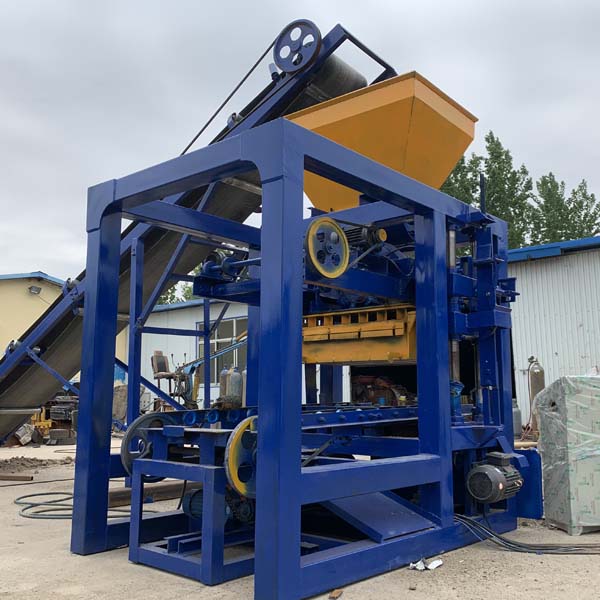
**Title: Greening Construction: Integration of Sustainable Materials in Full-Automatic Block Manufacturing**
**Introduction**
In an era marked by environmental consciousness and sustainable development, the construction industry is undergoing a transformative shift towards eco-friendly practices. Full-automatic block manufacturing, a cornerstone of modern construction, is not exempt from this trend. This article explores the integration of sustainable materials in full-automatic block manufacturing, highlighting the benefits, challenges, and strategies for creating more environmentally responsible construction solutions.
**1. **Recycled Aggregates and Materials:**
* **Benefits:** Incorporating recycled aggregates into full-automatic block production reduces the demand for virgin materials and minimizes waste. Recycled concrete, glass, or other construction materials can be used as viable substitutes, contributing to resource conservation.
**2. **Fly Ash and Industrial By-Products:**
* **Benefits:** Utilizing fly ash, a by-product of coal combustion, in full-automatic block manufacturing enhances the sustainability of the process. Fly ash is pozzolanic and can replace a portion of traditional cement, reducing the environmental impact associated with cement production.
**3. **Bamboo and Other Renewable Resources:**
* **Benefits:** Integrating renewable resources like bamboo fibers into full-automatic block production enhances the sustainability of the blocks. Bamboo, a rapidly renewable material, provides strength and flexibility, contributing to the overall durability of the blocks.
**4. **Hempcrete and Natural Fibers:**
* **Benefits:** Hempcrete, made from hemp fibers, lime, and water, is a sustainable alternative for full-automatic block manufacturing. Natural fibers like jute or coir can also be incorporated, reducing the carbon footprint of the blocks and promoting a healthier indoor environment.
**5. **Recyclable Packaging and Pallets:**
* **Benefits:** Sustainable practices extend beyond the block itself to include packaging. Using recyclable or biodegradable materials for packaging and pallets reduces the environmental impact associated with transportation and waste disposal.
**6. **Water-Based and Low-VOC Binders:**
* **Benefits:** Traditional binders in block manufacturing often involve high-VOC (Volatile Organic Compound) content. Switching to water-based or low-VOC binders contributes to improved indoor air quality and reduces the release of harmful pollutants during production.
**7. **Energy-Efficient Production Processes:**
* **Benefits:** Adopting energy-efficient technologies in full-automatic block manufacturing reduces overall energy consumption. This includes optimizing kiln operations, incorporating renewable energy sources, and implementing energy-efficient machinery.
**8. **Cradle-to-Cradle Design Principles:**
* **Benefits:** Applying cradle-to-cradle design principles ensures that full-automatic block products are designed with the end of their lifecycle in mind. This promotes recycling, reuse, or safe disposal, minimizing the environmental impact at every stage.
**9. **Life Cycle Assessments (LCAs):**
* **Benefits:** Conducting life cycle assessments of full-automatic block products helps manufacturers understand the environmental impact from raw material extraction to end-of-life. This data informs decisions to optimize processes and materials for sustainability.
**10. **Certifications and Eco-Labels:**
* **Benefits:** Seek certifications and eco-labels that validate the sustainability of full-automatic block products. Certifications like LEED (Leadership in Energy and Environmental Design) or BREEAM (Building Research Establishment Environmental Assessment Method) contribute to market credibility and consumer trust.
**Challenges and Strategies:**
**Challenges:**
– **Cost Implications:** Sustainable materials may initially come at a higher cost, impacting the economic viability of full-automatic block production.
– **Market Acceptance:** Educating the market about the benefits of sustainable materials is crucial for wider acceptance and adoption.
– **Regulatory Compliance:** Adhering to evolving environmental regulations and standards can pose challenges for manufacturers.
**Strategies:**
– **Economic Incentives:** Explore government incentives or subsidies that promote the use of sustainable materials in construction.
– **Educational Campaigns:** Conduct educational campaigns to inform stakeholders about the environmental benefits of full-automatic blocks with sustainable materials.
– **Collaboration and Research:** Collaborate with research institutions and industry partners to innovate and find cost-effective ways to integrate sustainable materials.
– **Advocacy for Standards:** Advocate for industry-wide standards that encourage and reward sustainable practices in full-automatic block manufacturing.
**Conclusion**
The integration of sustainable materials in full-automatic block manufacturing is a pivotal step toward creating a more environmentally conscious construction industry. By embracing recycled aggregates, renewable resources, and eco-friendly binders, manufacturers can contribute to a greener and more sustainable future. Overcoming challenges and adopting strategic approaches will not only enhance the environmental profile of full-automatic blocks but also position manufacturers as leaders in sustainable construction practices.
